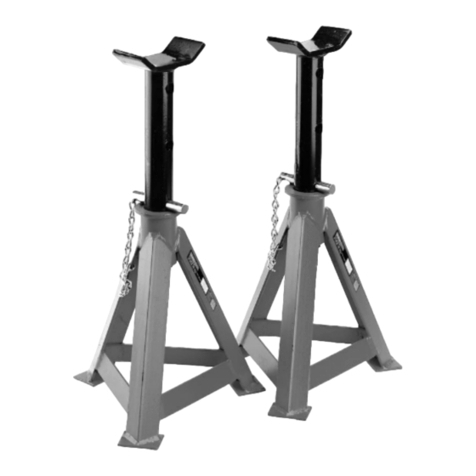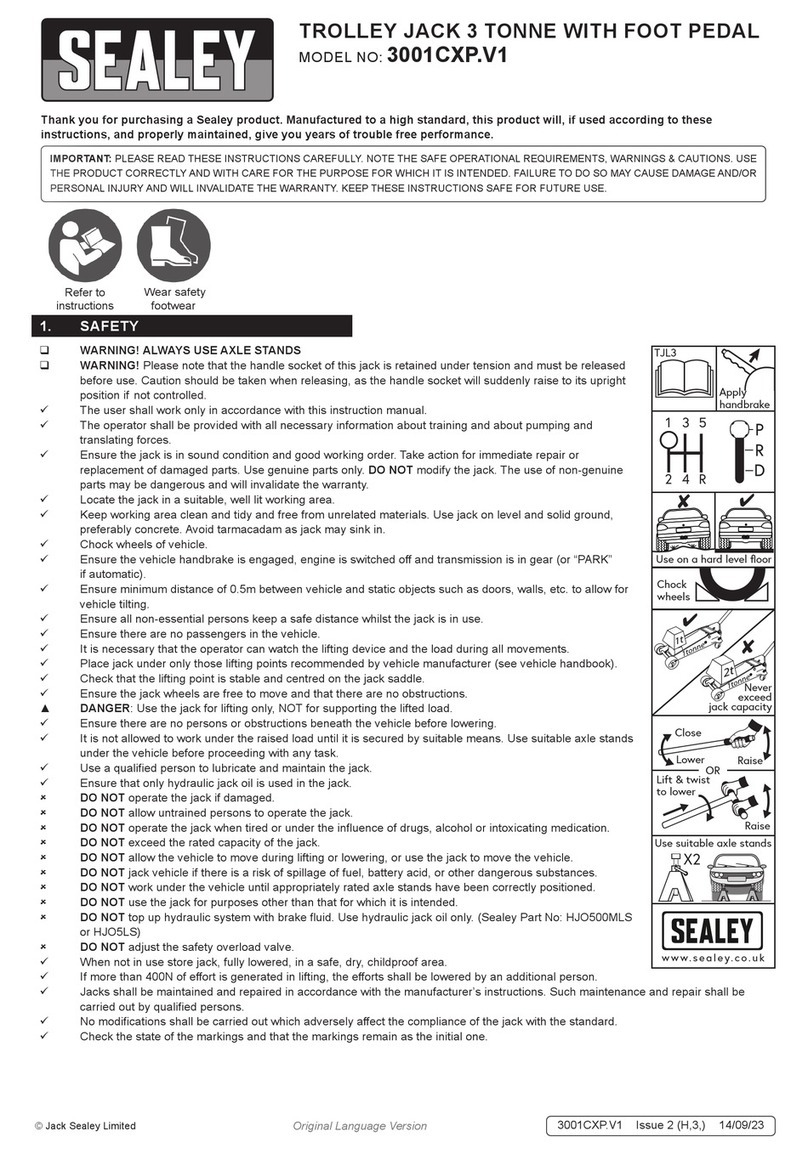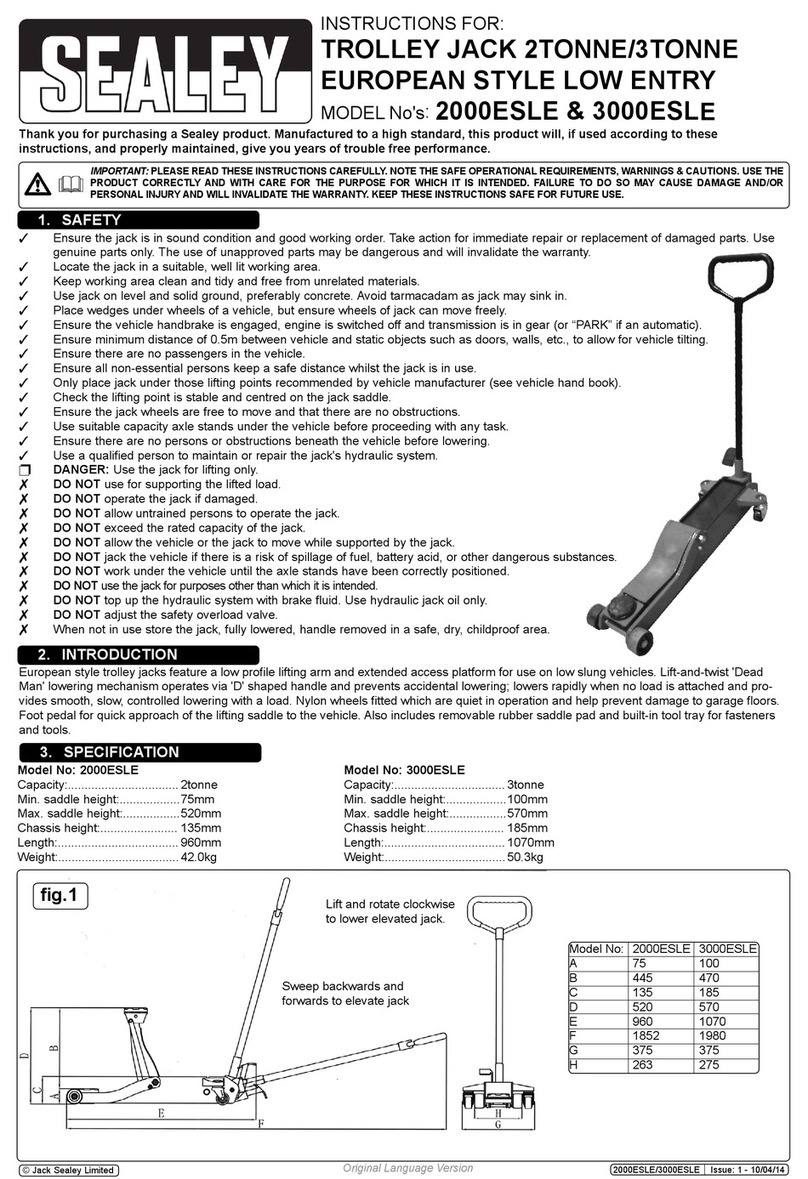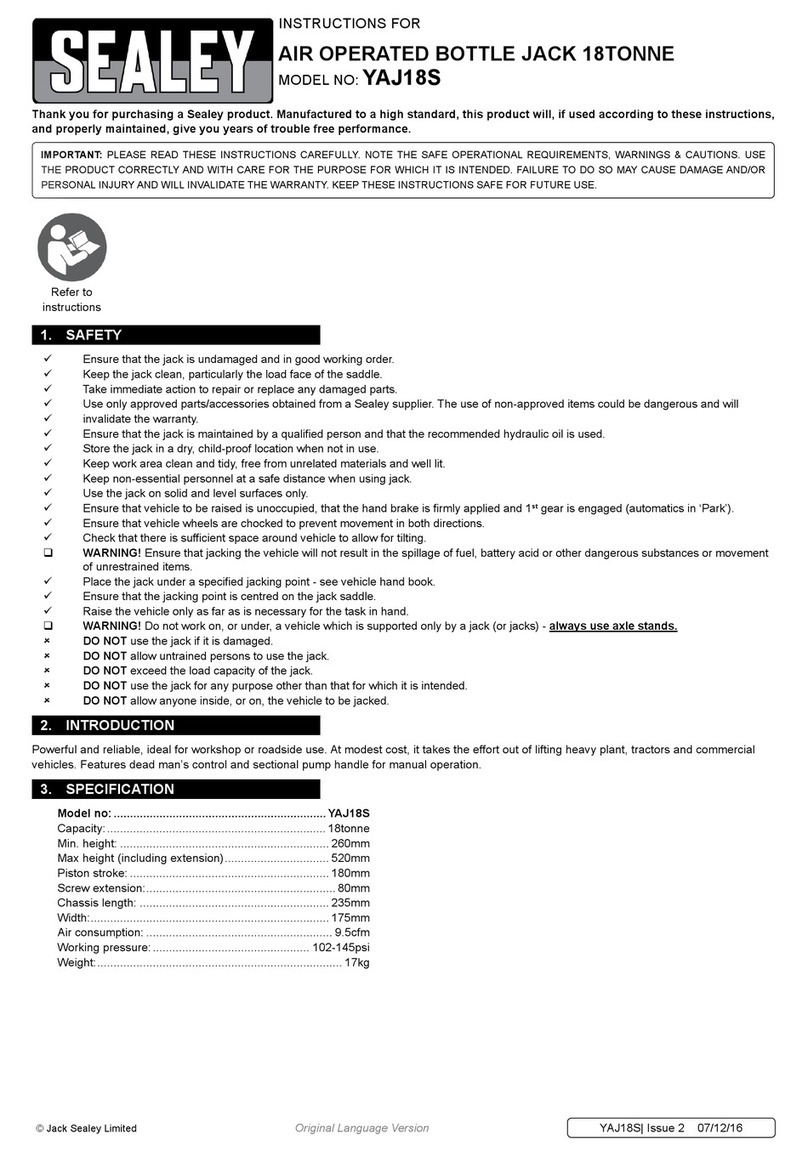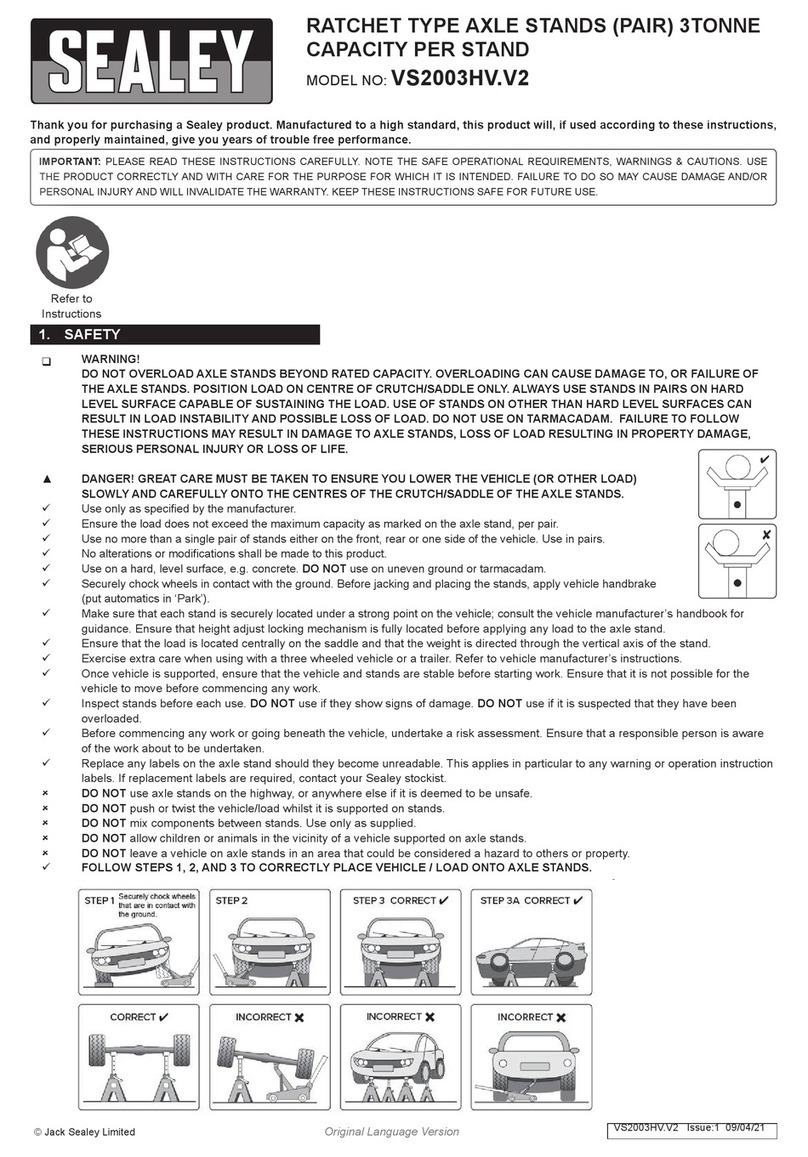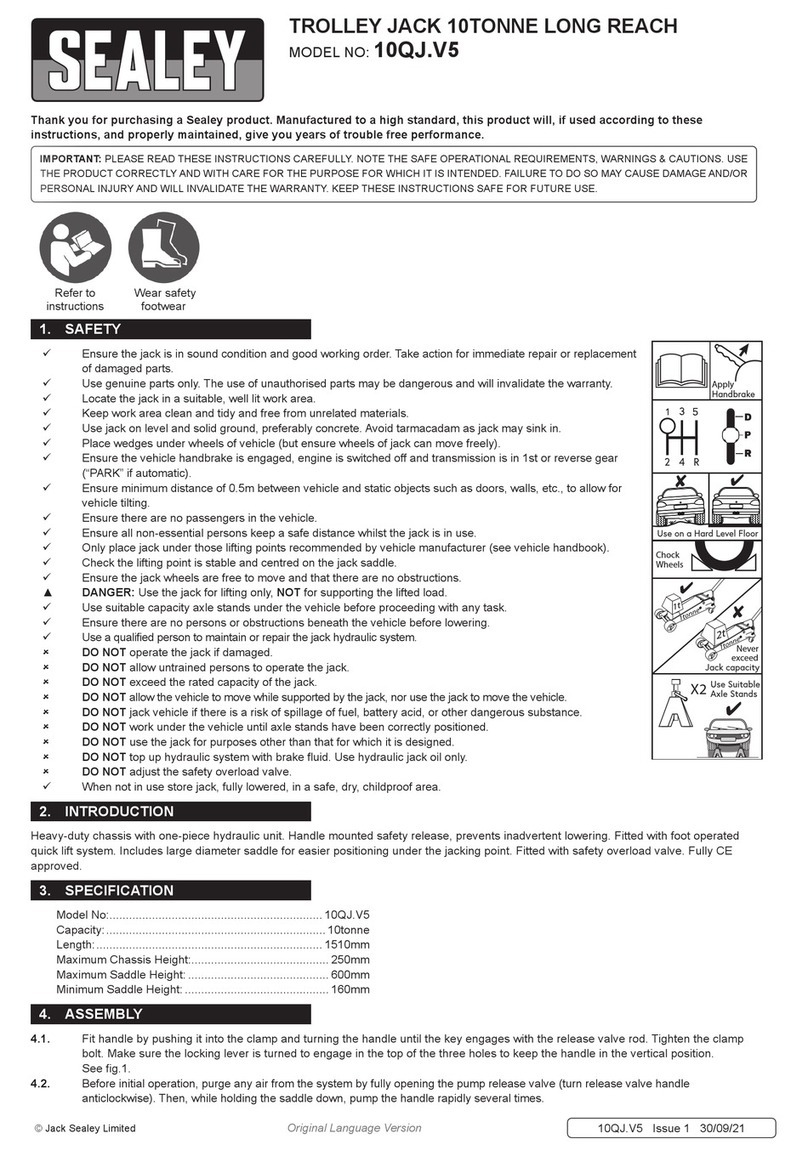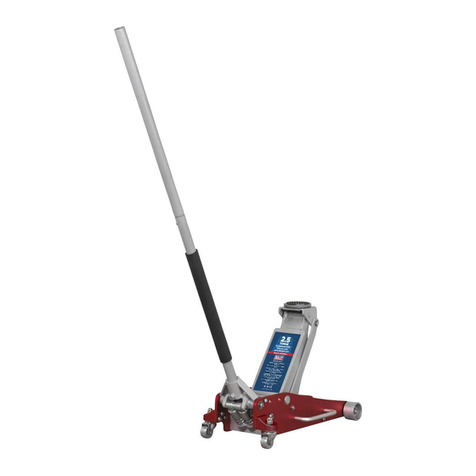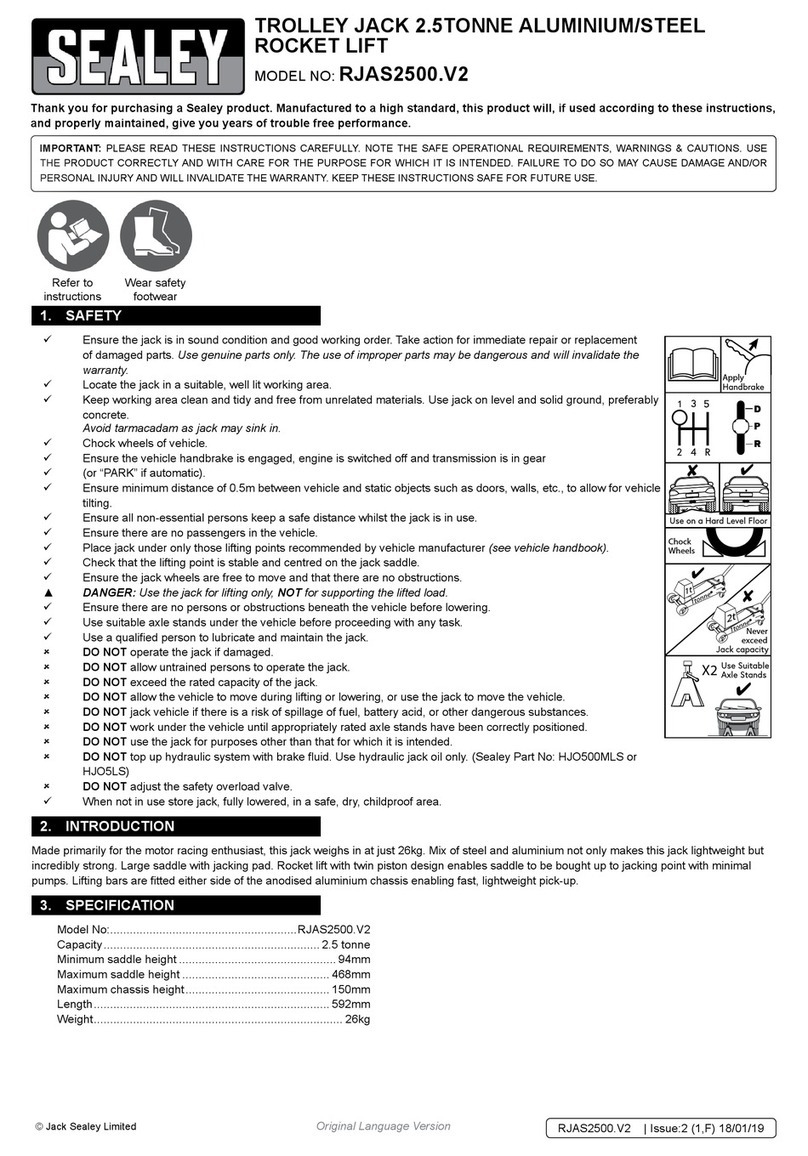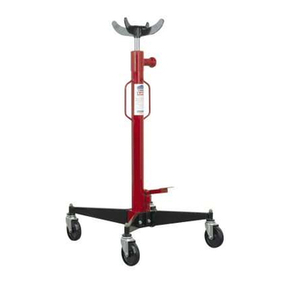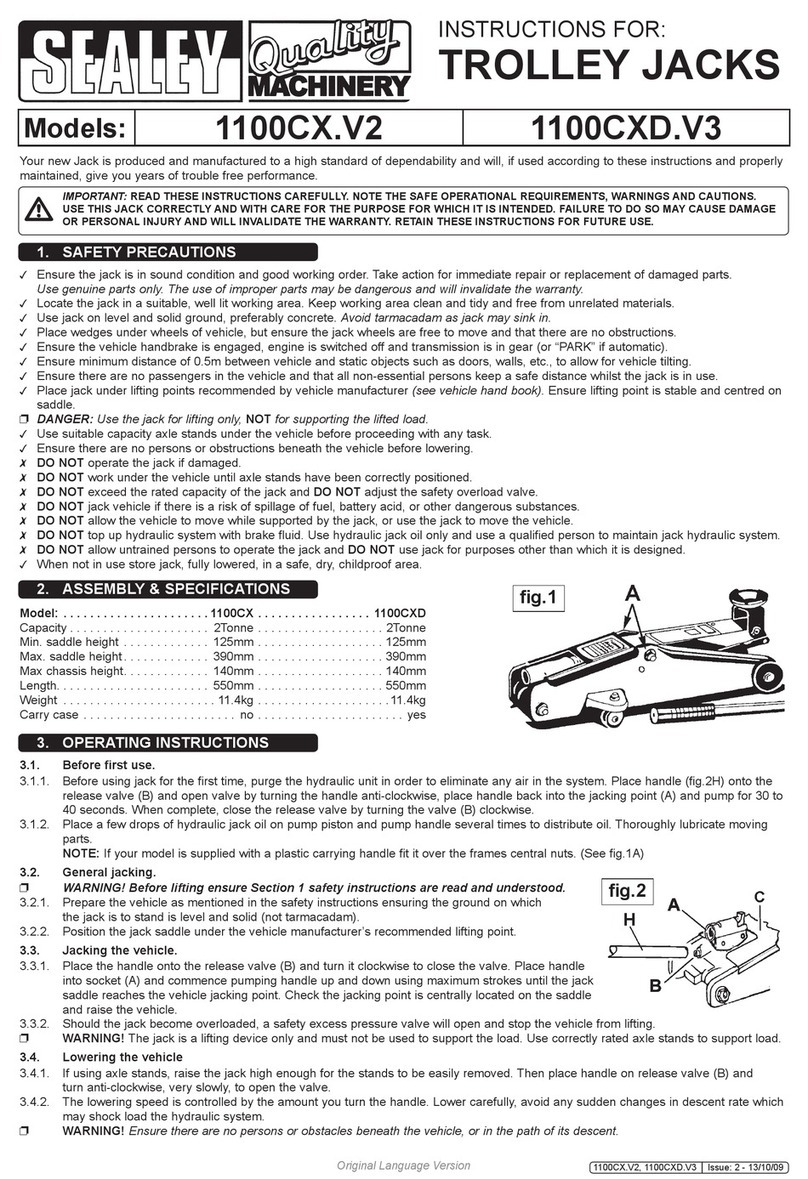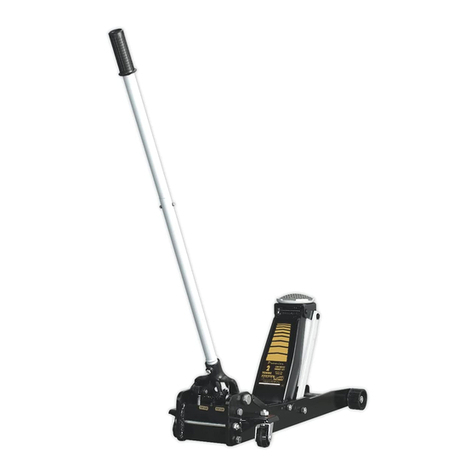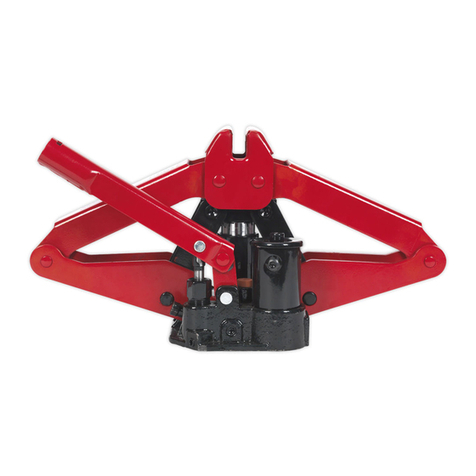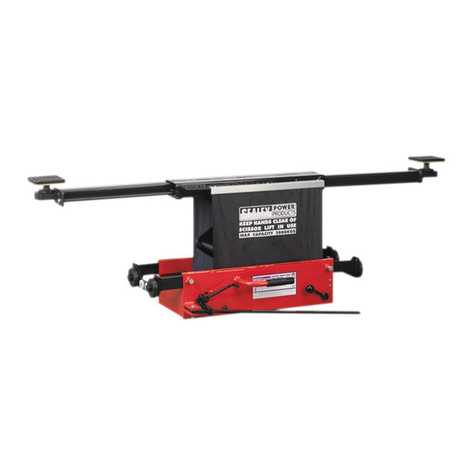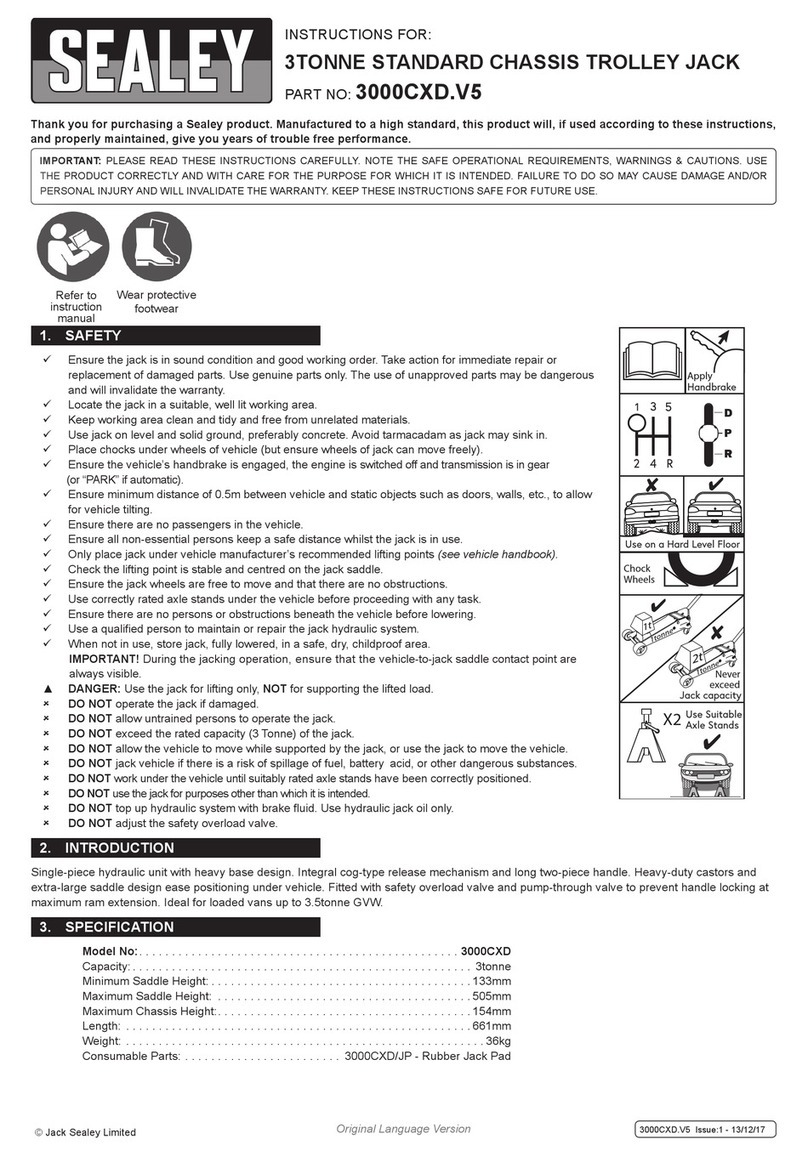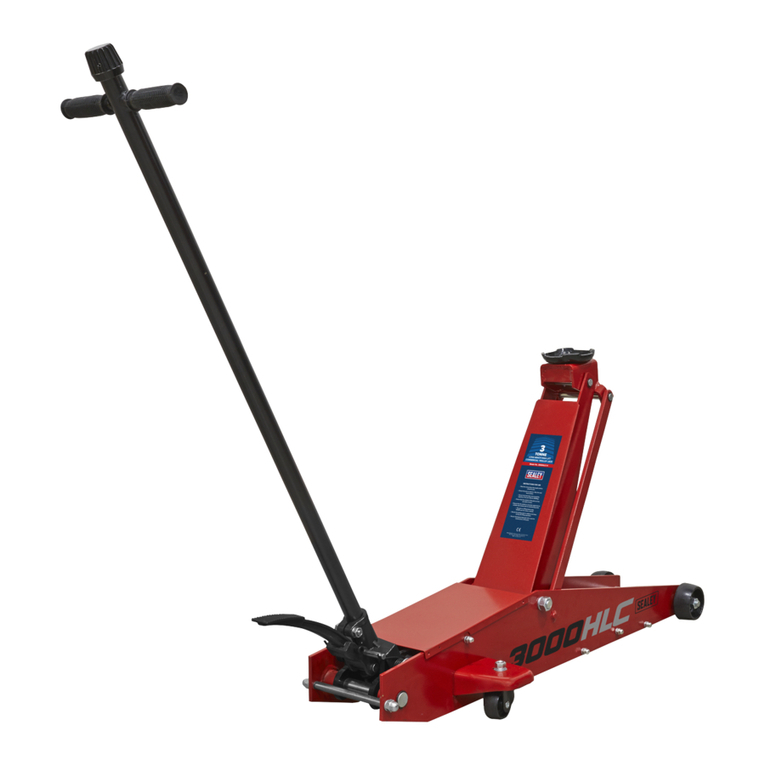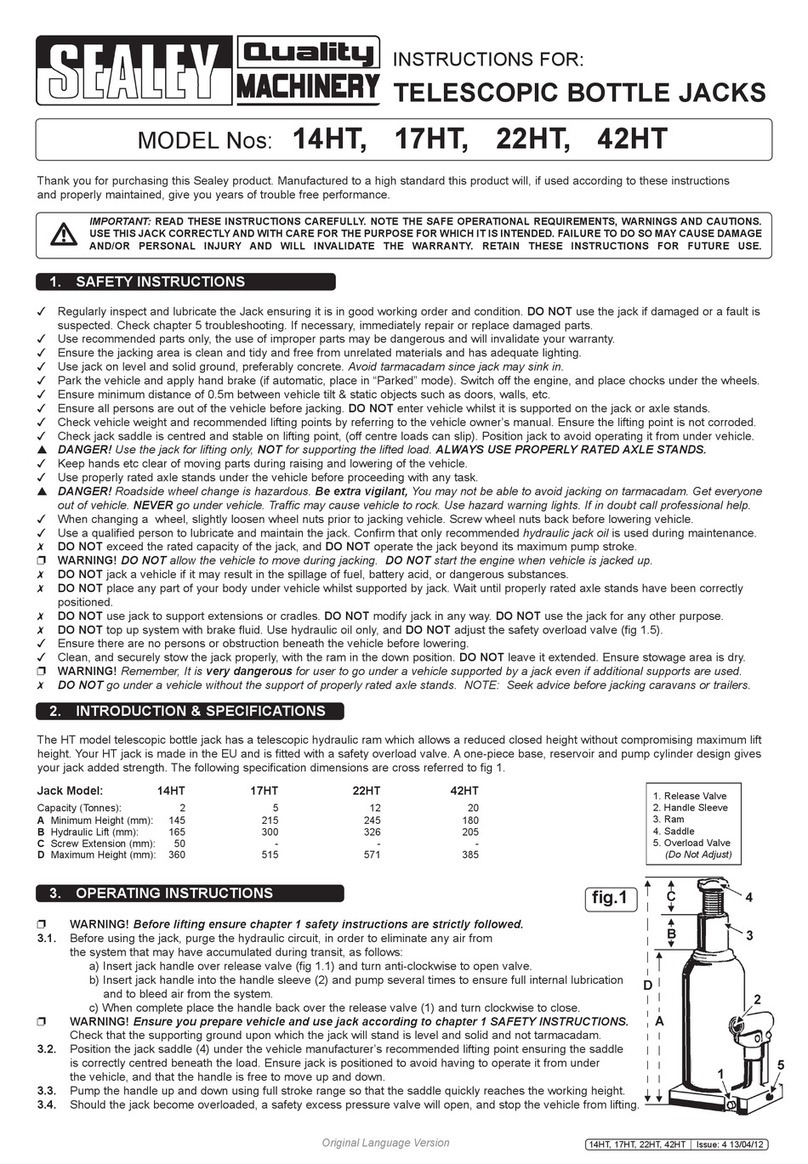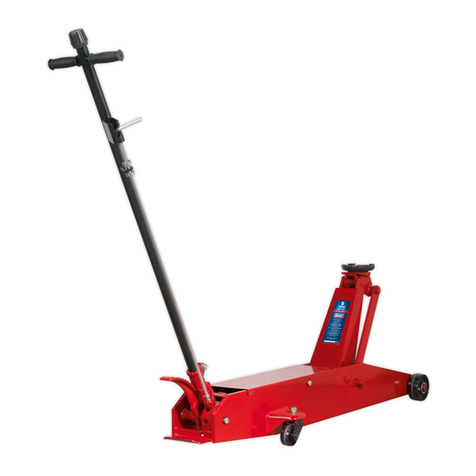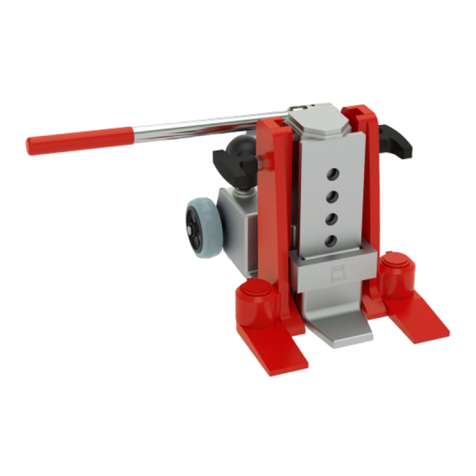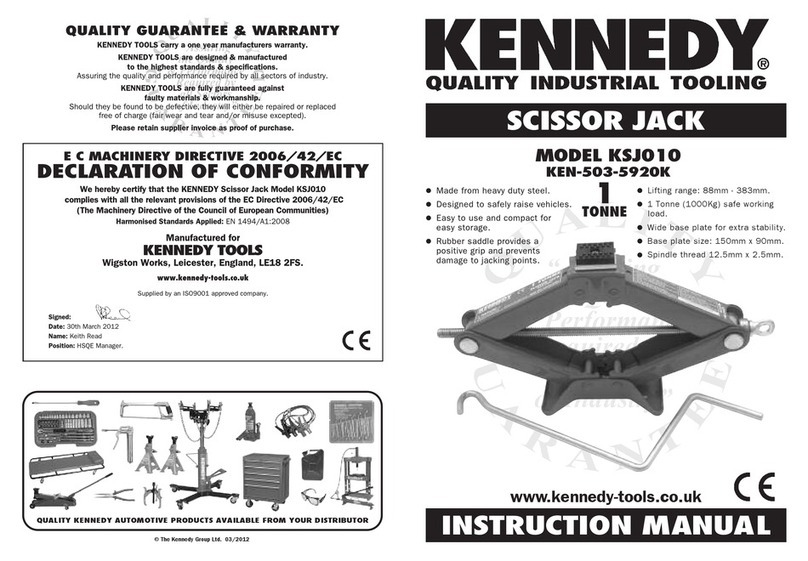
IMPORTANT: Only fully qualified personnel should
attempt maintenance or repair.
WARNING! Disconnect jack from air supply before changing
parts, servicing or performing any maintenance.
7.1. When the jack is not in use, the piston must be in the lowest
position to minimise corrosion.
7.2. Keep the jack clean and lubricate all moving parts, and the
air intake connector with air tool oil on a regular basis.
7.3. To check oil level, fully lower jack. Remove the filler plug
(located next to the piston or for YAJ20-40LR it is located on
the side of the jack). The oil level should be level with the
indicator inside the filler hole, for YAJ20-40LR, it should be
level with the bottom of the filler hole.
Top up the oil level if necessary but do not overfill as the jack
will become inoperative. If inadvertently overfilled the excess
oil should be poured off. After topping up or pouring off
excess oil it may become necessary to purge air from the
unit. See section 6.3 / 6.4.
NOTE: Use a good quality Jack oil, such a SEALEY HYDRAULIC
JACK OIL.
7. MAINTENANCE
8. TROUBLESHOOTING
NOTE: It is our policy to continually improve products and as such we reserve the right to alter data, specifications and component parts without prior notice.
IMPORTANT: No liability is accepted for incorrect use of this product.
WARRANTY: Guarantee is 12 months from purchase date, proof of which will be required for any claim.
INFORMATION: For a copy of our latest catalogue and promotions call us on 01284 757525 and leave your full name and address, including postcode.
01284 757500
01284 703534
sales@sealey.co.uk
Sole UK Distributor, Sealey Group,
Kempson Way, Suffolk Business Park,
Bury St. Edmunds, Suffolk,
IP32 7AR
www.sealey.co.uk
Web
email
Original Language Version YAJ15-30, YAJ15-30DC, YAJ20-40,
YAJ20-40DC, YAJ20-40LR Issue 2 - 13/03/12
PROBLEM POSSIBLE CAUSE REMEDY
Jack does not lift
but pump is ok.
1. Oil Exhausted.
2. Air in hydraulic
system.
3. Defective suction or
delivery valves.
4. Defective packing or
O-ring.
5. Poor quality oil.
1. Supply oil.
2. Drain air by.
opening cap plug
of suction and
delivery valves.
3. Clean clogged
valve.
4. Replace.
5. Replace oil.
Air pump does
not operate.
1. Insufcient
compressor power.
2. Pump oil used up.
1. Use a larger
compressor.
2. Find leak and
rectify, rell with
oil. Rebuild and
lubricate air valve.
Jack stops before
end of travel.
1. Hydraulic oil is
insufcient.
1. Supply oil.
Jack Lowers or
does not hold
in the raised
position.
1. Defective suction
delivery, release or
safety valve.
2. Defective piston
packing.
1. Clean and adjust
valve.
2. Replace packing.
Lifting is slow. 1. Air leakage due to
worn servo-valve.
1. Replace servo-
valve.
Pump continues
to operate when
the air valves
are closed
1. Air valve will not close. 1. Replace Valve.
WARNING! DO NOT use brake fluid, or any fluid other
than hydraulic jack fluid as this may cause serious damage to
the Jack and will invalidate the warranty!
7.4. Ensure the air filter located in the air valve is clean.
7.5. Should the piston not rise and the oil level is correct, this may
indicate a problem with air seeping into the hydraulic valve
passage. Purge any air from the system. See 6.3 / 6.4.
7.6. Confirm that the piston can rise to the highest position.
7.7. Before each use check for broken, cracked, bent, or loose
parts. Or any visible damage to welds, piston, pump, saddle,
air connector, levers, frame and all parts including nuts, bolts,
pins and other fasteners. If any suspect item is found, remove
jack from service and take necessary action to fix the problem.
DO NOT use the jack if believed to have been subjected to
abnormal load or shock. Inspect and take appropriate action.
7.8. Every three months remove the locking rings on the caster
wheels and lubricate the ball bearings with grease.
7.9. After a year of extensive use, the oil should be replaced in
order to extend the life of the jack. To drain the oil, remove
the filler plug and valve. Make sure that no dirt is allowed to
enter the hydraulic system See 7.3. for refilling instructions.
7.10. Periodically check the pump piston and piston rod for signs of
corrosion. Clean exposed areas with a clean oiled cloth.
IMPORTANT: NO RESPONSIBILITY IS ACCEPTED FOR INCORRECT USE OF
THE MACHINE.
Air / Hydraulic products are only repaired by local service agents. We have
service/repair agents in all parts of the UK. DO NOT RETURN JACKS TO US.
Please telephone us on 01284 757500 to obtain the address and phone number
of your local agent. If jack is under guarantee please contact your dealer.
De-commissioning the Jack
Should the jack become completely unserviceable and require disposal, draw off
the oil into an approved container and dispose of the jack and the oil according to
local regulations.
fig.5
6.6. Using the Jack - YAJ15-30DC, YAJ20-40DC
WARNING! ensure you have read and understood the safety
instructions in chapter 1 before commencing work.
6.6.1. Position the Jack under the vehicle
manufacturer’s recommended
jacking point (see vehicle hand book).
Note: Use the extension pins (fig.3D/fig.4C)
to get the jack closer to the jacking
point before engaging the jack. See
specification for capacity when using
the extension pins.
6.6.2. Whilst holding the main jack handle
lifting is achieved by pushing the 'up'
button (fig.6A).
6.6.3. When the vehicle has reached the
desired height release the 'up' button,
stopping any further air flow holding
the jack at the height to which it has
been raised.
6.6.4. Place axle stands correctly in position
and ensure chapter 1 safety
instructions are strictly applied before
performing any task.
6.7. Lowering the Jack
6.7.1. Ensure there are no persons or obstruction beneath the
vehicle before lowering, and remove any axle stands.
6.7.2. Whilst holding the main jack handle lowering is achieved by
pushing the control lever/button to down (fig.5A/fig.6B), and
the jack will lower in a controlled manner.
6.7.3. Once completely lowered releasing the control lever will
return it to the middle hold position. Remove the jack from
under the vehicle. If you have finished using the jack, turn the
air pressure supply off and disconnect the jack from the air
line and store the jack and air line accordingly.
fig.6
Parts support is available for this product. To obtain a parts listing and/or diagram, please log on to www.sealey.co.uk,
email sales@sealey.co.uk or phone 01284 757500.
